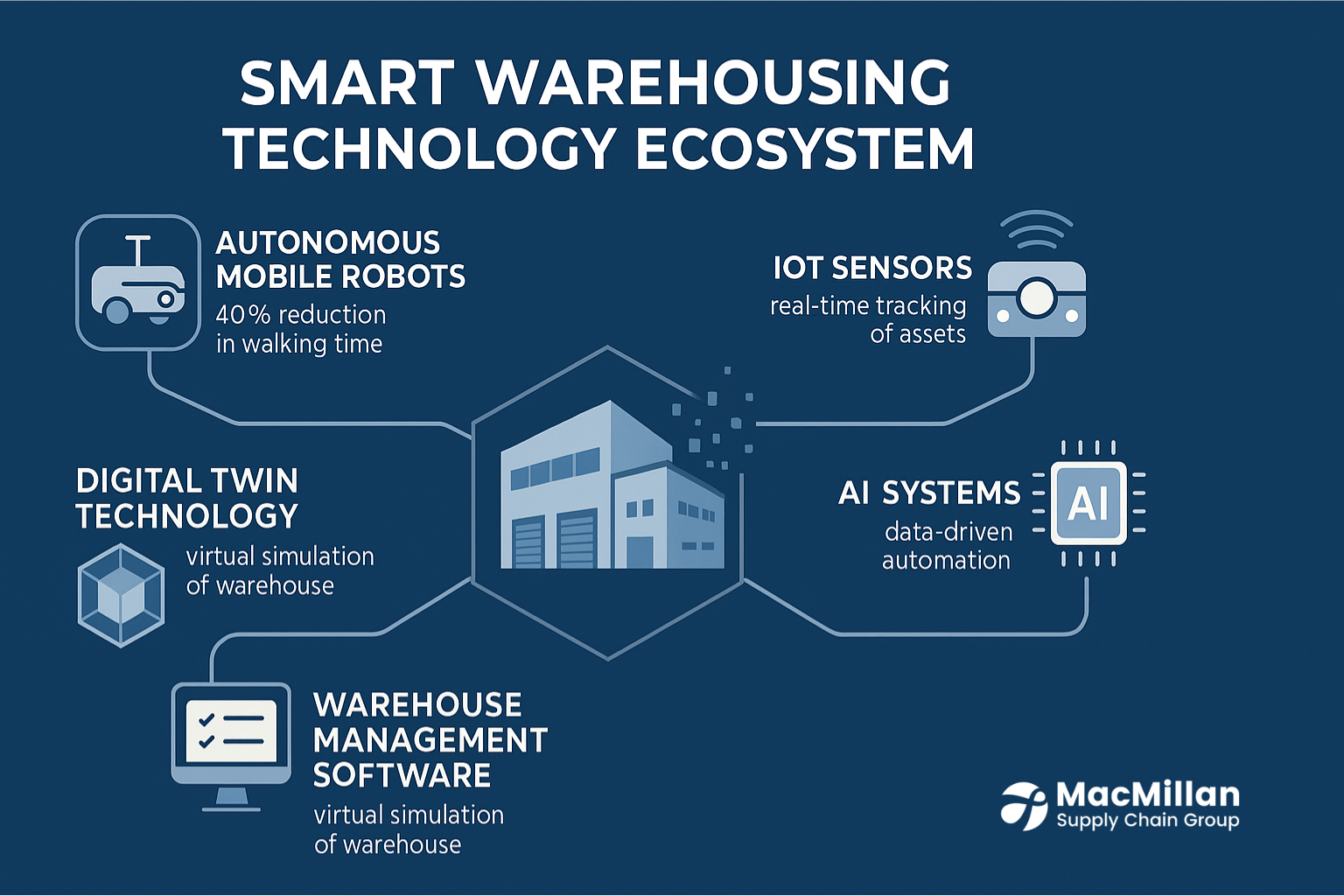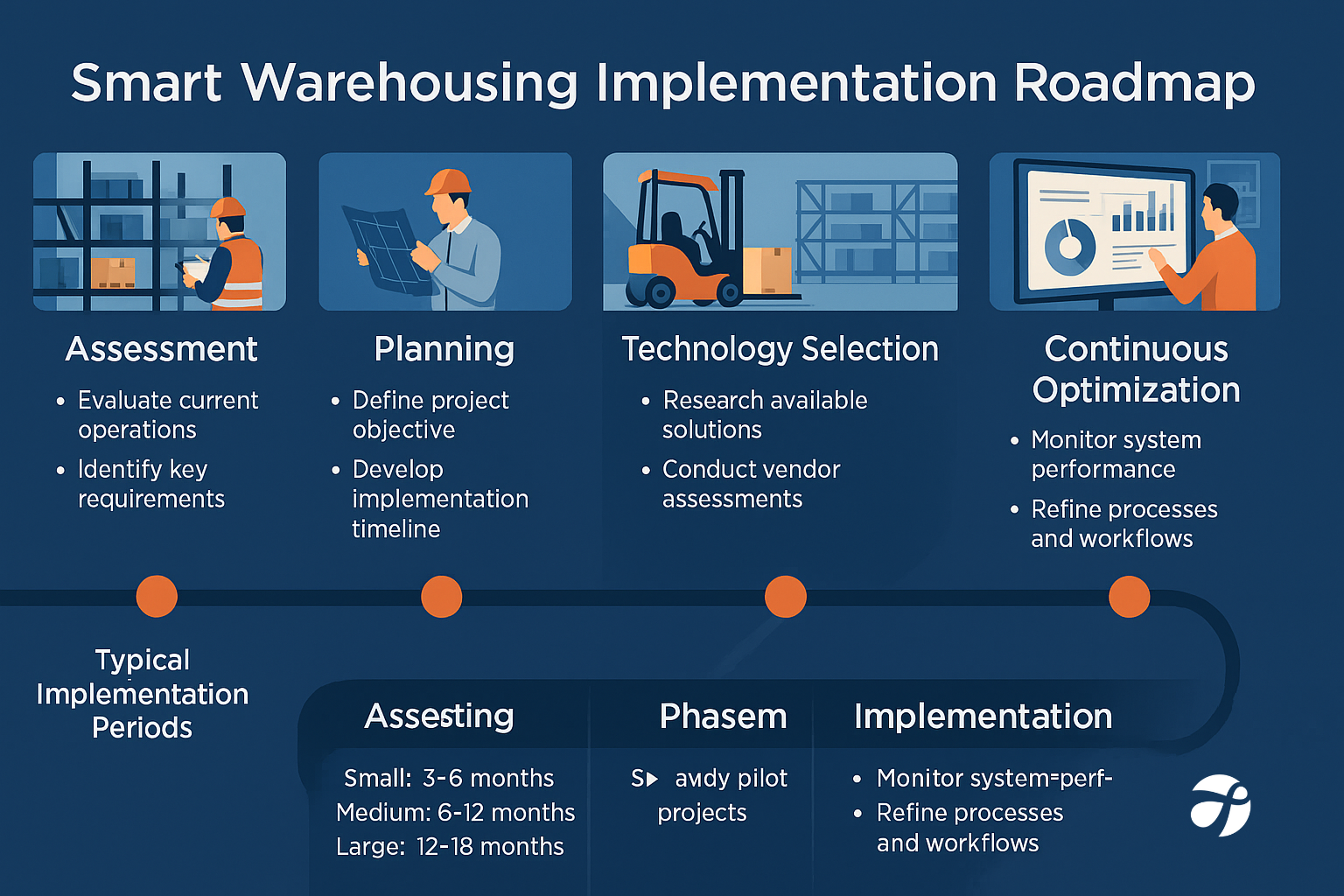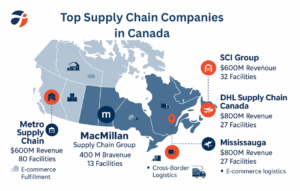A Quick Summary and Overview
Smart warehousing technology is revolutionizing the logistics industry through advanced automation, AI-powered systems, and IoT connectivity. This technology enables real-time inventory tracking, predictive analytics, and robotic fulfillment that significantly improve operational efficiency. With the global smart warehousing market projected to reach $80.44 billion by 2032, businesses across Canada are implementing these solutions to stay competitive. MacMillan Supply Chain Group offers cutting-edge smart warehousing solutions that help Canadian businesses optimize operations, reduce costs, and meet growing customer demands in an increasingly digital marketplace.
The Smart Warehousing Revolution in Canadian Logistics
The logistics industry is experiencing a fundamental shift. Gone are the days of clipboard-wielding workers manually tracking inventory and paper-based systems. Today’s warehouses are becoming intelligent hubs where robots, AI, and IoT sensors work together to create unprecedented efficiency.
Smart warehousing technology represents the convergence of physical operations and digital capabilities. But what exactly makes a warehouse “smart”? It’s the integration of technologies like autonomous mobile robots, IoT-enabled logistics systems, and advanced warehouse management software that can predict needs before they arise.
For Canadian businesses facing labor shortages, increasing customer expectations, and competitive pressures, smart warehousing isn’t just a fancy upgrade—it’s becoming essential for survival. At MacMillan Supply Chain Group, we’re helping companies across Canada embrace this technological revolution to stay ahead in an increasingly complex supply chain landscape.
Core Technologies Driving Smart Warehouse Innovation
The foundation of any smart warehouse is built on several key technologies working in harmony. Let’s explore the innovations that are transforming traditional warehouses into intelligent operations centers:
Autonomous Mobile Robots (AMRs)
Unlike their predecessors that required magnetic strips or predefined paths, today’s AMRs navigate warehouses independently using advanced sensors and mapping capabilities. These robots reduce walking time for employees by up to 40% and can operate 24/7 without breaks. At MacMillan, we’ve seen these robots increase picking efficiency by nearly 200% compared to traditional methods.
IoT-Enabled Logistics Networks
The Internet of Things (IoT) creates a network of connected devices throughout the warehouse. Temperature sensors monitor sensitive products, proximity detectors prevent collisions, and smart shelves track inventory in real-time. This connectivity provides unprecedented visibility into warehouse operations, allowing managers to make data-driven decisions instantly rather than waiting for end-of-day reports.
AI and Machine Learning Systems
Artificial intelligence serves as the brain of smart warehousing, analyzing patterns and making predictions that humans simply couldn’t process. These systems optimize inventory levels, predict maintenance needs before equipment fails, and continuously improve picking routes. Predictive analytics in warehousing has reduced stockouts by up to 30% for our clients while simultaneously decreasing excess inventory.
Transforming Operations with Warehouse Automation
Warehouse automation is changing every aspect of logistics operations, from receiving to shipping and everything in between. Here’s how automation is revolutionizing key warehouse processes:
Automated Receiving and Putaway
When shipments arrive, automated scanning systems immediately identify and log items without manual counting. Autonomous forklifts and conveyor systems then transport products to their optimal storage locations, determined by AI algorithms that consider factors like demand frequency and product relationships. This automation reduces receiving time by up to 60% while improving accuracy to nearly 99.9%.
Robotic Order Fulfillment
Perhaps the most visible form of warehouse automation is robotic order fulfillment. Collaborative robots work alongside human pickers or independently retrieve items from storage. These systems can process orders up to three times faster than manual methods while reducing error rates significantly. For e-commerce fulfillment in CA, this speed and accuracy directly translates to customer satisfaction and repeat business.
Intelligent Sortation and Shipping
At the shipping stage, automated sortation systems direct packages to the correct loading dock based on destination, carrier, and priority. Weight-checking stations verify package accuracy, while automated labeling systems ensure proper documentation. This end-to-end automation creates a seamless flow from order receipt to delivery, minimizing touchpoints and maximizing efficiency.
Data Intelligence: The Brain Behind Smart Warehousing
While robots and automation provide the muscle of smart warehousing, data intelligence supplies the brainpower. Advanced warehouse management systems collect, analyze, and act on information in ways that transform operations:
Real-Time Inventory Visibility
Smart warehousing eliminates the dreaded “where is it?” question that plagues traditional operations. RFID tracking solutions and connected scanners provide instant location data for every item in the warehouse. This real-time inventory visibility reduces search time by up to 80% and virtually eliminates lost inventory, a common problem that costs warehouses millions annually.
Digital Twin Technology
One of the most exciting developments in smart warehousing is digital twin technology—virtual replicas of physical warehouses that update in real-time. These digital models allow managers to visualize operations, test changes in a risk-free environment, and identify bottlenecks before they impact performance. At MacMillan, we’ve implemented digital twins that have improved space utilization by 25% and throughput by 30%.
Predictive Analytics for Demand Forecasting
Using historical data, market trends, and even weather patterns, predictive analytics helps warehouses anticipate demand fluctuations with remarkable accuracy. This foresight allows for proactive inventory management, labor scheduling, and resource allocation. Our clients using these systems have reduced carrying costs by 15-20% while improving order fulfillment rates.
Canadian Logistics Innovations and Market Trends
Canada’s unique geography, climate, and market conditions have driven specific innovations in smart warehousing technology:
Adapting to Canadian Climate Challenges
Smart warehousing in Canada must account for extreme temperature variations that can affect both equipment and inventory. IoT-enabled climate control systems maintain optimal conditions while minimizing energy usage. Cold-chain monitoring for pharmaceuticals and food products has become increasingly sophisticated, with sensors that track temperature variations down to 0.1°C and automatically alert managers to potential issues.
Cross-Border Supply Chain Integration
With approximately 75% of Canadian exports going to the United States, smart warehousing systems in Canada often focus on seamless cross-border integration. Advanced tracking and documentation systems ensure compliance with customs requirements while minimizing delays. These systems have reduced border-related delays by up to 40% for businesses implementing smart logistics solutions.
Sustainable Supply Chain Initiatives
Canadian warehousing trends show increasing emphasis on sustainability. Smart warehouses reduce environmental impact through optimized routing (reducing fuel consumption), energy-efficient lighting controlled by motion sensors, and waste reduction through precise inventory management. Green logistics strategy isn’t just environmentally responsible—it delivers measurable cost savings and appeals to increasingly eco-conscious consumers and business partners.
Challenges in Adopting Smart Warehousing Technology
While the benefits of smart warehousing are clear, implementation isn’t without challenges:
High Initial Investment Costs
The upfront costs of automation equipment, software systems, and facility modifications can be substantial. Many businesses struggle to justify these expenses despite the long-term ROI. Additionally, ongoing maintenance and upgrade costs must be factored into the total investment calculation.
Integration with Legacy Systems
Most warehouses don’t have the luxury of building from scratch. Integrating new technologies with existing systems often creates compatibility issues that require custom solutions. Data migration from older systems can be particularly challenging and time-consuming.
Workforce Adaptation and Training
Smart warehousing changes job requirements and workflows, sometimes creating resistance among employees. Comprehensive training programs are essential but add to implementation timelines and costs. Finding workers with the right technical skills to operate and maintain advanced systems presents another challenge.
Cybersecurity Vulnerabilities
As warehouses become more connected, they also become more vulnerable to cyber threats. Cybersecurity for smart warehouses must address potential vulnerabilities in networked equipment, data storage systems, and remote access points. A single breach could potentially shut down operations or compromise sensitive customer information.
MacMillan’s Approach to Smart Warehousing Implementation
At MacMillan Supply Chain Group, we’ve developed comprehensive strategies to overcome the challenges of smart warehousing implementation while maximizing the benefits for our clients:
Phased Implementation Strategy
Rather than attempting a complete warehouse transformation overnight, we recommend a strategic, phased approach. This method allows businesses to:
- Start with high-impact, lower-cost technologies that deliver immediate ROI
- Test solutions in controlled environments before full-scale deployment
- Spread investment costs over time while beginning to realize benefits quickly
- Build employee confidence through gradual change management
For example, we helped a Toronto-based retailer implement RFID tracking solutions in a single department before expanding to their entire operation. This approach delivered a 35% efficiency improvement in the test area, providing proof of concept and building momentum for the broader implementation.
Custom Integration Solutions
Our technology specialists develop tailored integration plans that bridge the gap between legacy systems and new technologies. We prioritize:
- Middleware solutions that enable communication between disparate systems
- API development for seamless data exchange
- Staged data migration with comprehensive validation
- Hybrid operational models during transition periods
For a Montreal distribution center, we created custom interfaces between their existing ERP system and new robotic picking technology, preserving their investment in core business systems while adding advanced capabilities.
Comprehensive Workforce Development
We recognize that technology is only as effective as the people who use it. Our implementation plans always include:
- Skills assessment and personalized training programs
- Change management strategies to build buy-in
- Cross-training to ensure operational flexibility
- Career development paths that emphasize new technical skills
When implementing collaborative robotics at a Vancouver facility, we created a “Technology Champion” program that identified tech-savvy employees and provided advanced training. These champions then helped train their colleagues, accelerating adoption and reducing resistance.
End-to-End Security Framework
Our approach to cybersecurity for smart warehouses includes:
- Network segmentation to isolate critical systems
- Regular vulnerability assessments and penetration testing
- Continuous monitoring for unusual activity
- Comprehensive backup and disaster recovery plans
- Employee security awareness training
This multi-layered approach has helped our clients maintain operational integrity even as their technology footprint expands.
Sustainable Technology Selection
We prioritize technologies that deliver both operational and environmental benefits:
- Energy-efficient automation systems
- Smart lighting and climate control
- Route optimization to reduce fuel consumption
- Packaging optimization to reduce waste
For a Calgary client, our green logistics strategy reduced energy consumption by 32% while simultaneously improving throughput by 45%—proving that sustainability and efficiency can go hand-in-hand.
Getting Started with Smart Warehousing: Your Next Steps
Ready to transform your warehouse operations with intelligent technology? Here’s how to begin your smart warehousing journey:
Assessment and Planning
Start by evaluating your current operations to identify opportunities for improvement. Which processes consume the most time? Where do errors typically occur? What are your biggest operational challenges? This assessment will help prioritize technology investments for maximum impact.
Document your current workflows, systems, and performance metrics to establish a baseline for measuring improvement. Consider bringing in experts to conduct a comprehensive warehouse audit—they often spot opportunities that internal teams might miss.
Setting Clear Objectives
Define specific, measurable goals for your smart warehousing initiative. Rather than simply “implementing technology,” focus on outcomes like “reduce picking errors by 50%” or “decrease order fulfillment time by 30%.” These concrete objectives will guide technology selection and help measure ROI.
Building the Right Team
Smart warehousing requires a blend of logistics knowledge and technical expertise. Consider whether you need to hire new talent, train existing staff, or partner with external specialists. The right implementation team can make the difference between success and costly setbacks.
Partner with MacMillan Supply Chain Group
Don’t navigate the complex world of smart warehousing alone. MacMillan Supply Chain Group offers comprehensive support for businesses at every stage of technological transformation:
- Expert assessment of your current operations
- Custom technology roadmaps aligned with your business goals
- Implementation support from experienced project managers
- Ongoing optimization and performance monitoring
- Access to cutting-edge technologies without massive capital investment
Our team brings decades of experience in Canadian logistics innovations and intelligent warehousing solutions. We understand the unique challenges of implementing smart warehousing technology in the Canadian market and have developed proven strategies to overcome them.
Contact MacMillan Supply Chain Group today to schedule a consultation with our smart warehousing specialists. Let us help you transform your logistics operations for greater efficiency, accuracy, and competitive advantage in today’s demanding marketplace.
Frequently Asked Questions About 3PL Fulfillment Center Location Selection
A smart warehouse uses advanced technologies like automation, artificial intelligence, and IoT connectivity to improve efficiency and accuracy. Unlike traditional warehouses that rely heavily on manual processes, smart warehouses leverage data and automation to optimize operations. Key components include warehouse management systems, robotic order fulfillment, RFID tracking solutions, and predictive analytics. These technologies work together to create an intelligent ecosystem that can adapt to changing conditions and continuously improve performance.
Implementation costs vary widely depending on warehouse size, existing infrastructure, and the specific technologies deployed. A basic system with RFID tracking and warehouse management software might start around $50,000 for a small operation, while comprehensive automation with robotics and AI can require investments of several million dollars for large facilities. However, most businesses see ROI within 18-36 months through labor savings, improved accuracy, and increased throughput. Many providers now offer "robotics-as-a-service" models that reduce upfront costs.
Rather than eliminating jobs, smart warehousing typically transforms them. While some manual tasks may be automated, new roles emerge in technology maintenance, system optimization, and exception handling. Most facilities find they can redeploy workers to higher-value activities that require human judgment and problem-solving skills. The technology also helps address labor shortages by making existing workers more productive and creating safer, more appealing work environments that improve retention.
Smart warehousing dramatically improves inventory accuracy through technologies like RFID tracking, computer vision systems, and weight-based verification. These systems provide real-time inventory visibility and eliminate manual counting errors. Automated systems record every movement of inventory and can perform continuous cycle counts without disrupting operations. Our clients typically see inventory accuracy improve from industry averages of 63-97% to over 99.5% after implementing smart tracking systems.
As warehouses become more connected, cybersecurity becomes increasingly important. Key concerns include unauthorized access to systems, data breaches affecting customer information, and operational disruptions from malware or ransomware. Implementing proper network segmentation, strong authentication protocols, regular security updates, and comprehensive employee training are essential steps. Working with technology partners who prioritize security and maintain compliance with standards like ISO 27001 can help mitigate these risks.
Smart warehousing contributes to sustainability through multiple mechanisms. Energy management systems reduce power consumption by optimizing lighting, heating, and cooling based on actual usage. Route optimization for both in-warehouse movement and outbound logistics reduces fuel consumption and emissions. Predictive analytics improves inventory management, reducing waste from expired or obsolete products. Additionally, paperless processes eliminate the need for printed documents, while optimized packaging systems reduce material usage.
Absolutely! While full warehouse automation might be cost-prohibitive for smaller operations, many smart warehousing technologies are scalable and accessible to SMBs. Cloud-based warehouse management systems offer sophisticated capabilities without major infrastructure investments. Mobile scanning solutions and basic automation can deliver significant improvements with modest investment. Additionally, working with a 3PL like MacMillan Supply Chain Group gives smaller businesses access to advanced technologies without having to implement them independently.
Implementation timelines vary based on the scope and complexity of the project. Basic warehouse management system implementations might take 3-6 months, while comprehensive automation projects can span 12-24 months for large facilities. Phased implementations allow businesses to realize benefits incrementally rather than waiting for complete project completion. Factors affecting timeline include facility readiness, integration requirements with existing systems, staff training needs, and technology complexity.
Smart warehousing directly impacts customer satisfaction through faster, more accurate order fulfillment. Real-time inventory visibility reduces stockouts and backorders. Automated picking and packing processes improve order accuracy, reducing returns and customer complaints. Faster processing times enable later order cutoff times while still meeting next-day delivery promises. Additionally, the data captured by smart systems enables better communication with customers about order status and delivery timelines.
When selecting a technology partner for smart warehousing implementation, consider their experience with similar businesses in your industry, particularly in the Canadian market. Look for partners who offer comprehensive services from assessment through implementation and ongoing support. Evaluate their integration capabilities with your existing systems and their approach to training and change management. The best partners focus on your business objectives rather than simply selling technology, and they should be able to demonstrate clear ROI for their proposed solutions.







